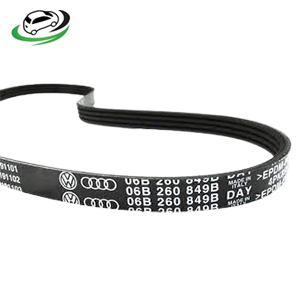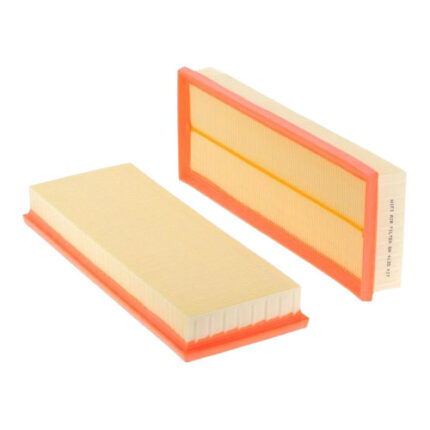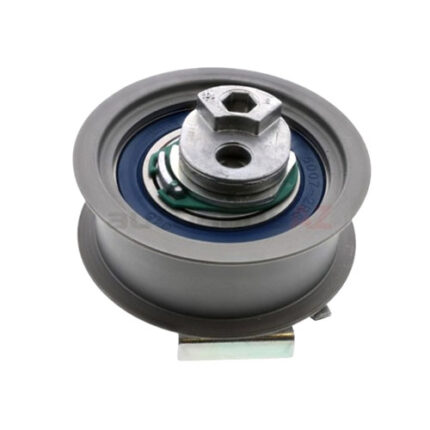Get VW Passat with 2.0T Timing Belt Tensioner Engine 06D109243B in Kenya
The timing belt tensioner is a crucial component in a vehicle’s engine, specifically within the timing belt system. It plays a vital role in maintaining the proper tension and alignment of the timing belt, which is essential for the smooth and accurate operation of the engine. Here’s a detailed explanation of what a timing belt tensioner is, how it works, why it’s important, and how it should be maintained.
What is a Timing Belt Tensioner?
The timing belt tensioner is a mechanical device designed to apply tension to the timing belt, ensuring it remains tight and properly aligned. The timing belt is responsible for synchronizing the rotation of the engine’s crankshaft and camshaft(s), which allows the engine’s valves to open and close at the correct times during the combustion cycle. Without proper tension, the timing belt could slip or jump, leading to engine misalignment and potential damage.
Types of Timing Belt Tensioners
There are two main types of timing belt tensioners:
- Manual Tensioners: These require manual adjustment to maintain the correct tension on the timing belt. Mechanics or technicians adjust the tension manually during installation or routine maintenance.
- Automatic Tensioners: These use a spring-loaded mechanism or hydraulic system to automatically maintain the correct tension on the timing belt. They adjust the tension as needed based on the engine’s operation, making them more convenient and reliable than manual tensioners.
How Does the Timing Belt Tensioner Work?
The timing belt tensioner operates by applying a consistent force against the timing belt, keeping it tight and ensuring it stays in place on the pulleys that connect the crankshaft and camshaft(s). Here’s how it works in more detail:
- Maintaining Tension: The tensioner keeps the timing belt taut by applying pressure against it. This tension is crucial because it prevents the belt from becoming too loose or too tight, both of which could cause problems with engine timing.
- Adjusting for Wear and Stretch: Over time, the timing belt may stretch slightly due to the heat and stress of engine operation. The tensioner compensates for this by adjusting the tension to ensure the belt remains properly tensioned.
- Preventing Slippage: A loose timing belt can slip off the pulleys or jump teeth, leading to misalignment of the engine’s valves and pistons. The tensioner helps prevent this by ensuring the belt stays securely in place.
- Absorbing Vibrations: The tensioner also helps absorb and dampen vibrations from the engine, reducing wear on the timing belt and ensuring smoother operation.
Why is the Timing Belt Tensioner Important?
The timing belt tensioner is vital for several reasons:
- Ensures Proper Engine Timing: The tensioner helps maintain the correct timing between the crankshaft and camshaft(s). Proper timing is crucial for the engine to run efficiently and avoid problems such as misfires, rough idling, or loss of power.
- Prevents Engine Damage: If the timing belt slips or jumps, it can cause the engine’s valves and pistons to collide, leading to significant engine damage. The tensioner helps prevent this by keeping the belt properly tensioned and aligned.
- Extends Timing Belt Life: By maintaining proper tension and reducing stress on the belt, the tensioner helps extend the life of the timing belt. This can reduce the frequency of belt replacements and prevent unexpected breakdowns.
- Supports Smooth Engine Operation: A properly functioning tensioner contributes to the overall smoothness of the engine’s operation. It reduces vibrations, minimizes noise, and helps ensure consistent engine performance.
Signs of a Failing Timing Belt Tensioner
A failing timing belt tensioner can lead to serious engine problems. Here are some common signs that the tensioner may be failing:
- Unusual Noise: A failing tensioner may produce unusual noises, such as squealing, rattling, or grinding sounds. These noises can indicate that the tensioner’s bearings are worn or that the tensioner is not maintaining proper tension on the belt.
- Belt Slippage: If the tensioner is not functioning correctly, the timing belt may slip or jump, leading to engine misalignment. This can cause erratic engine performance, loss of power, or difficulty starting the engine.
- Engine Misfires: A loose or slipping timing belt can cause the engine’s valves and pistons to become misaligned, leading to engine misfires, rough idling, or decreased fuel efficiency.
- Visible Wear or Damage: Inspecting the tensioner may reveal visible signs of wear or damage, such as cracks, corrosion, or a worn-out spring. These issues can affect the tensioner’s ability to maintain proper tension on the belt.
- Vibration or Movement: Excessive vibration or movement in the timing belt area may indicate a problem with the tensioner. This can occur if the tensioner is not properly aligned or if its internal components are worn out.
Maintaining the Timing Belt Tensioner
Proper maintenance of the timing belt tensioner involves several key practices:
- Regular Inspections: Periodically inspect the tensioner for signs of wear, damage, or misalignment. Regular inspections can help identify potential issues before they lead to more significant problems.
- Check for Proper Tension: Ensure that the timing belt has the correct tension. If the tensioner is manual, it may need to be adjusted periodically to maintain the proper tension.
- Listen for Unusual Noises: Pay attention to any unusual noises coming from the timing belt area, such as squealing or rattling. These sounds can indicate a problem with the tensioner that may need attention.
- Replace Worn Components: If the tensioner shows signs of significant wear or damage, replace it promptly. It’s often recommended to replace the tensioner at the same time as the timing belt to ensure both components are in good condition.
- Follow Manufacturer’s Recommendations: Adhere to the vehicle manufacturer’s recommended maintenance schedule for the timing belt and tensioner. This helps ensure that these components are replaced at the appropriate intervals.
Replacing the Timing Belt Tensioner
If the timing belt tensioner fails or shows signs of significant wear, it’s important to replace it. Here’s a general guide to the replacement process:
- Preparation: Gather the necessary tools, a new timing belt tensioner, and any other required parts. Ensure the engine is cool and secure the vehicle on a flat surface.
- Access the Timing Belt: To reach the tensioner, you’ll need to remove any components that obstruct access to the timing belt, such as engine covers, pulleys, or other accessories.
- Release Tension: If the tensioner is automatic, you’ll need to release the tension on the timing belt using a wrench or special tool. If it’s a manual tensioner, you may need to loosen the adjustment bolt.
- Remove the Old Tensioner: Carefully remove the old timing belt tensioner from its mounting position. Be prepared for some debris or coolant to spill during this process.
- Install the New Tensioner: Position the new tensioner in place and secure it with bolts or fasteners. Ensure it is properly aligned and tightened according to the manufacturer’s specifications.
- Reinstall the Timing Belt: Reinstall the timing belt, ensuring it is properly aligned with the camshaft and crankshaft pulleys. Adjust the tension as needed according to the manufacturer’s recommendations.
- Check Operation: Start the engine and check for any signs of noise, vibration, or misalignment. Ensure the timing belt operates smoothly and that the new tensioner is functioning correctly.
Follow us on Facebook for more parts.




